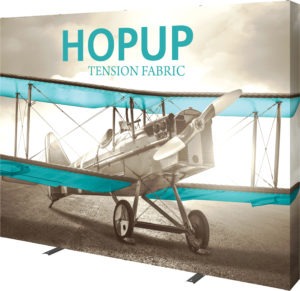Setting up a trade show booth is both an art and a science. No matter how hard you try to have a standard booth, you may run into issues as you move from show to show. Even though the allotted space can vary at each location, designing the optimal-sized trade show booth is very important. If your booth is too large, then it can reduce the effect of the visuals you need visitors to focus on. If the booth is too small, visitors may feel cramped and uncomfortable and they’ll move on. So the question is: What are the Best Dimensions for My Trade Show Booth?
While predicting the future is not part of the trade show tool box, you can get good estimates from the show manager as to how many people will attend. According to the Center for Exhibition Research (CEIR), attendance at trade shows has been forecast to grow through 2024. By following industry standards, and the following tips, you can prepare a list of parameters for booth set-up that will draw in these visitors and promote conversations and conversions.
Plan for Your Complete Presentation
While planning the dimensions of your booth, consider carefully what you will use the booth for throughout the convention. Many vendors give demonstrations throughout the trade show duration. Others talk about their products, while a third group displays their product line and allow visitors to self-guide through technology.
Each of these types of behaviors creates a different need for space in the booth. When planning the size and layout, make sure to include space for people to gather in front of and inside your booth for demonstrations or other activities. As CEIR mentions, 81% of show attendees have buying authority, therefore it is important to create a booth with maximum impact and usefulness.
Follow Industry Standards
Every industry has specific standards for booth sizes and individual venues may also. Consult with the show manager to find out what space issues may apply for your show. Then you can comply with any rules and regulations that the show requires. Some of these space issues may have to do with local safety ordinances, the size of the venue space or fire industry regulations. If your booth seems like it may not fit the standard size, the show manager can let you know if you can get permission to use it anyway.
Use Common Sense for Set-Up and Take-Down Times
A rule of thumb for trade show booths is that you should be able to set up within two hours or less and take them down in 60 minutes or less. Unless you have a massive booth space, this rule is a good one to live by. Therefore, design your booth with this timeline in mind. Create and organize your displays so that you can pack them in the order that you need to set them up the next time. Design a set-up and take-down plan you use every time you assemble your booth for a show.
Maximize Your Booth’s Purpose
 Is your booth the right size to achieve your trade show goals?
Is your booth the right size to achieve your trade show goals?
Look at your display from every angle to see if the booth is doing it’s job. Whether your primary purpose is to network for leads, set up appointments, sell a new product or introduce a service, your booth display needs to drive that goal. With your purpose in mind, examine the size, implementation and flow of the booth. Do you see areas that can be improved upon to get better results? If so, test your theories on other people before putting them into practice. With proper tests, you can compare your results to find the ultimate trade show booth display.
Look at Competitors’ Booths
Keep abreast of the trade show booths of the competitors you admire to look for ways you can outshine them. Find the niche or technique that your competitors are missing out on and take advantage of it. Your booth design can reflect this change through the concept, presentation or implementation. For instance, if your competition seems to miss the mark on a key demographic, create a booth that will draw that demographic to you. It may be an interactive computer program or a hands-on demonstration. Design your booth around this center.
Be Flexible
What are The Best Dimensions for My Trade Show Booth? It is Murphy’s Law that your booth set up may not be as perfect as you think. Something may go wrong. Fire restrictions may have changed, or part of your display malfunctions. It is a best practice to have a suitable plan B for when Murphy’s Law runs counter to your needs. Be as flexible as you can so that you can still run your booth if part of the setup is missing. Put simply, the dimensions that work best for your booth are the ones that fit your need and the restrictions of the show.


